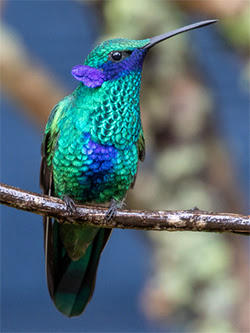Celebration of birds draws record number of participants for one-day count
 |
|
|
Ithaca, NY— On May 5, Global Big Day birders tallied nearly 7 out of 10 species known to exist on the planet. That works out to record-shattering results: more than 6,900 bird species recorded by more than 28,000 participants.
During Global Big Day, a celebration of the world's birds, participants report their observations to the eBird website (ebird.org) run by the Cornell Lab of Ornithology. "Big Day" is the term used for any attempt to see or hear as many bird species as possible in 24 hours.
"If you get people all around the world going out birding on the same day, we can find most of the species of birds and then really start to understand them," says Chris Wood at the Cornell Lab. "And along the way, it’s a great way to expose people to birds and spark what for many people will become a lifelong passion."
Passionate bird watchers in Colombia upheld their enviable status as the country reporting the greatest diversity of birds. Global Big Day participants there reported more than 1,500 out of a possible 1,900 species—even the country's president and the air force were counting birds! Nipping at their heels was rival powerhouse Peru where the final species total was an astonishing 1,490 species. Bird watchers from more than 150 countries took part in the massive bird-watching event.
The Cornell Lab's Team Sapsucker, sponsored by LOWA Boots LLC, fielded three teams linking three far-flung locations along the Pacific Flyway used by migratory birds during spring and fall: Monterey County, California, Honduras, and northern Colombia. The midnight to midnight runs for these squads, made up of top-notch local eBird partners and birders from the Cornell Lab, yielded 592 species in habitats ranging from low-lying desert to breath-stealing mountain tops. Final species totals for each Lab group:
The Sapsuckers' combined checklist is a kaleidoscopic cross-section of the birds of the Americas, including 25 species of hummingbirds, 6 types of trogons, 30 kinds of raptor, 59 flycatcher species, and 37 species of shorebirds. One of the goals of this Big Day is to raise awareness about the urgent need to restore and protect key coastal sites for migrating shorebirds.
"It's so amazing to think about Sanderlings departing California in a couple of days to go breed in the Canadian Arctic," says the Cornell Lab's Brian Sullivan, part of the California Sapsucker team. "Meanwhile Sooty Shearwaters have just arrived from islands in the South Pacific. Birds use our planet in such a different way than we do."
Bottom line? Never before have so many birders gone out in this many countries, found so many birds, and reported them to eBird for fellow birders, researchers, and conservationists to use. And that is indeed something to celebrate.
--If you'd like a bird-by-bird account of the Sapsuckers' Global Big Day and their final species list, visit https://www.allaboutbirds.org/bigday2018/.
--To check final tallies from around the world, go to https://ebird.org/globalbigday
--To read more about results from regions around the world, such as Europe, Asia, Africa, etc. visit https://ebird.org/news/global-big-day-2018-a-birding-world-record
--To make a Global Big Day donation to support bird conservation, visit https://give.birds.cornell.edu/page/21158/donate/
###
Media contact:
Pat Leonard, Cornell Lab of Ornithology, (607) 254-2137, pel27@cornell.edu